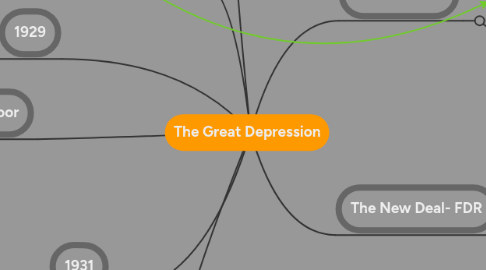The Great Depression
저자: Dan Tucker

1. 1920
1.1. Good economic times
2. 1929
2.1. Tuesday, Oct. 29th the stock market crashed causing a depression until 1942
3. Panic selling
3.1. Everyone tried to sell at once, so bottom of market dropped out.
4. The Poor
4.1. The poor couldn't afford to buy hardly anything, unemployment rose, causing productivity to be cut back.
5. 2nd Major Problem
5.1. There was an uneven distribution of wealth. 42% of families were below the poverty line.
5.1.1. Hoovers Response- Didn't believe that the GVT should play an active role in the economy. Organized some private agencies for unemployed.
6. 1931
6.1. Hovers response seemed successful, but then the soviets flooded the world market with cheap wheat (1/2 U.S. price) in an attempt to get money to pay back Austrian banks ( but price was too low and they couldn't) This resulted in the BANKERS’ PANIC Austrian banks borrowed from German banks and appealed to the BANK OF INT'L SETTLEMENT
6.2. Austrian banks and loaning German banks therefore were forced into bankruptcy # and b/c German banks had borrowed from Americans, U.S. banks began to go bankrupt, wiping out life savings of thousands of Americans
7. 1932 Election
7.1. 1 out of 4 people were unemployed, Income was 50% of what it had been in 1929. Franklin D Roosevelt won all but 6 states to win the election by a landslide.
8. The New Deal- FDR
8.1. The New Deal, this was the name FDR gave his new plan to fight the great depression. This plan was a revolution in American society, changed way the government functioned
8.2. Step 1 dealt exclusively with the banking issues. Many banks were shut down and inspected and weren't allowed to re open until were seen as "healthy".
8.3. Step 2 was more about reforming the stockmarket,
8.4. Step 3 was to put more $ into circulation for the country, FDR went off the gold standard.


